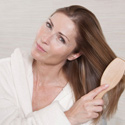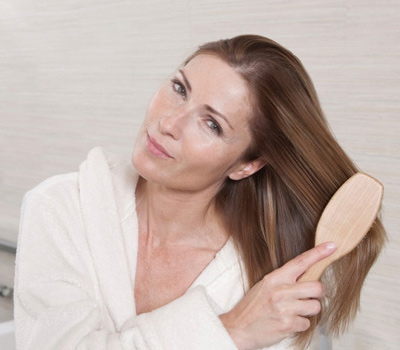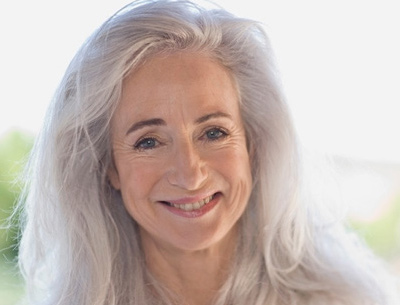
06 Feb Female Alopecia

Hair loss is more common in older ladies but, since it is largely hormonal driven, can really be seen in any age. It is not uncommon to see the beginnings of genetic and hormonal hair loss in women as young as thirty.
Female Hair Loss
What does a bald guy know about hair loss treatments? It is a fair question and one you may have asked if you glanced at my photo. Well losing my hair in my early twenties has spawned an appetite for the topic, if not a healthy dose of vengeance towards the process. As life altering as it was for me though, I still cannot imagine how devastating going bald is to a woman. At least I had icons like Michael Jordan and Andre Agassi to pave the way for me. Can you name a famous bald woman? Society accepts baldness on the male but still does a double take if a female walks by with a shiny head. Often people assume the woman is having health issues.
Women show up in the office with a Ziploc bag full of hair, old photos, or even a hairbrush choked full of strands. Fear, embarrassment, and uncertainty are written on their faces—but so is the desire to fight back.
If you Google “women’s hair loss” over 68 million hits arise. The majority of these are attempting to prey upon the purse by peddling cures and vitamins. Some reasonable “informational websites” do abound—all with convenient helpful links to worthless products. Usually whatever factual medical info is provided is slanted heavily towards their sponsors.
Alopecia & Causes Of Hair Loss
Doctors refer to hair loss as alopecia. It is an old Greek term for “fox”. Evidently the fox grows mangy and sheds its fur. This is probably the one time in woman’s life she doesn’t want to be compared to a fox.
Hair is really what I like to think of as a “biological luxury.” It is not necessary to our survival or the propagation of our species. It is normal to lose about 100 to 150 hairs a day. We deposit some on the pillow, in our brushes, and down the drain. After shampooing, up to 250 hairs can be expected to vacate your head. And since our hair density naturally starts to thin as we marinate through the decades, hair loss itself is not really a disease. Problems arise however when our scalp fails to replace lost hair with new hair. Every hair on your head is in one of three different stages of its natural life cycle: growing, resting, and shedding. Luckily the majority of hairs linger in the growing phase, and stay in this mode for several years before closing down shop and going dormant; allowing a newby to replace it by then falling out into your hairbrush or shower drain.
Hormonal changes and a complex soup of genetic factors underlie about half of hair loss cases I see. The entity known as Female Pattern Hair Loss usually entails women noticing a widening of their part or thinning at the crown. Often preservation of the frontal hairline can be seen. It is more common in older ladies but, since it is largely hormonal driven, can really be seen in any age. It is not uncommon to see the beginnings of genetic and hormonal hair loss in women as young as thirty.
When hair just starts shedding diffusely all over the scalp, disruptions in the natural growth-shedding cycle need to be investigated. Pregnancy, menopause, stress, surgery, or major life changes can underlie this diffuse shedding. Often this type of alopecia resolves on its own in a few month—which seems like an eternity when it’s happening to you.
Even overt attacks by one’s own immune system against their own hair is possible, and not rare at all. This may cause painful boils or sores on the head but can also be completely painless and patchy. For various reasons, the immune system wakes up one day and decides to attack your hair like it’s a foreign invader (This is one of the many reasons I recommend people refrain from gobbling down so-called “immune boosting” pills). Sometimes the immune system’s attack is so vicious that it leads to permanent destruction of the hair.
Also vitamin deficiency and excess, fungus, sexually transmitted diseases, medications (like blood pressure pills), and good old fashion American stress play their parts in going bald. Tight braiding or even too strong of a ponytail can put so much traction on your hair follicle that it actually dies and leaves behind scar tissue. And of course we see our fair share of women pulling out their otherwise healthy hair and wondering why they go bald. Every dermatologist has sat and watched someone yank on their locks while swearing upon their dead mother’s grave they never do such. The consequences of unconscious habits and behaviors are also the most challenging to treat.

Most of the time, there turns out to be no medically concerning reason for hair loss. Often this does not lessen the emotional sledgehammer with which these women must wrestle.
Treaments For Female Hair Loss
So the reasons for hair loss are myriad. One product cannot cover all the potential causes. Biopsy, blood tests, and a conversation with your doctor should help you get to the root of the problem. By painlessly harvesting a few millimeters (about the size of pencil eraser) of skin, you can zero in on the cause and correctly direct your efforts where they need to be. Although some blood tests can be helpful in evaluating hair loss, there is no substitute for a biopsy. I’ve seen many patients settle for only blood tests, have some marginal abnormality identified, and subsequently misdirect their treatment. Noticed a change to your nails or eyelashes? Anything you feel may be pertinent to your hair loss needs to be shared with your doctor to better direct testing.
Most of the time, there turns out to be no medically concerning reason for hair loss. Often this does not lessen the emotional sledgehammer with which these women must wrestle. While there is no FDA-approved treatment for women’s hair loss, that doesn’t mean we do not get creative. Off-label uses of medications are the backbone of our treatments. I often prescribe a common prostate medication for my female patients to slow down and even regrow some hair. Of course women do not have prostate glands so I’m never too irritated whenever I get questioned on these prescriptions. Ask your dermatologist about other off-label treatments that are safe for you.
Minoxidil (Rogaine) is actually a decent product and I try to get all my adult women with thinning hair on it. It needs to be used for up to six months before results are noticed; so many abandon it prematurely and conclude it doesn’t work. You can buy the generic for about $15 for a two month supply if you shop around. Ask your dermatologist for tips on what strength to buy. Sometimes you can augment this with low dose injections to the balding areas with highly diluted cortisone or taking a certain water pill that has a strange side effect of hair growth. Hair transplants, wigs, and camouflaging hair-bulking agents can be utilized in combination for excellent results also. Ask your doctor for recommendations.
Setting realistic expectations is key. Do not expect to start treatment when you are seventy years old and then be upset when your hair doesn’t get as thick as it was when you first went to see Gone with the Wind in theatres. The success of reclaiming your hair should be measured on a spectrum. It is not at all hopeless and there is a lot you can do to fight back. With enough time and the right treatment, we usually can bring back the one thing besides hair I like to see in a patient: a smile.

